STEEMCHURCH FARMS: The cultivation of Onion (Alliuum cepa)
With this new publication I would like to reiterate my support for the project STEEMCHURCH FARMS (@Farms) of @abiye, my regards to Mr. @ Sirknight, for making this important humanitarian project a reality. With my publications, I want to contribute with this important cause. I hope that this new issue on agriculture can help many parishioners of the church, who today plan to develop their agricultural projects.
"I am the bread of life," Jesus said, "whoever comes to me will never go hungry, and whoever believes in me will never be thirsty again" Psalm 107: 9
The cultivation of the onion, (Alliuum cepa), has been one of my favorite crops, and one of the crops that has given me many satisfactions. Today I want to share my experiences with all members of the Steemit community, where I will explain everything related to this important crop in a simple way. The content of this course will begin with a brief review of its origin that I managed to get online. Of the vegetative cycle, the elaboration of nurseries, the transplant, the furrows for the irrigation, the fertilization, the control of weeds, the control of pests and diseases, the curing and the harvest.

Source
The cultivation of the Onion: (Allium cepa)
The onion is among the first cultivated plants, as far as its origin, many texts say that its origin is located in Central Asia.
Onion morphology:
The onion, as it is commonly called, has a radicular system formed by numerous fasciculate radicles, of whitish color, shallow, that come out from a stem as a disc, or disc caulinar.
The onion stalk:
It is the one that supports the inflorescence; it is straight, hollow, with ventral inflation in its lower half.
Onion leaves:
The leaves are envainadoras, elongated, fistulous and pointed in their free part.
Onion bulb:
It is formed by cells that have a relatively large size and have elongated or oval shapes. These cells are linked together by a substance called pectin (which is produced by the cell wall), whose function is to give firm structure and protection to the Allium cepa bulb. Source
Onion (Allium cepa) It is a food that is characterized by its low caloric value and high fiber content. It contains significant amounts of potassium, calcium and some vitamins.
Onion consumption (Allium cepa), is associated with the reduction of blood lipids, cholesterol and antiplatelet activity, factors that contribute to reduce the risk of cardiovascular disease, one of the leading causes of death in many countries.Source
The sowing of the onion will depend on the type of onion, depending on the weather and hours of sun, which correspond to the location of the land where we are going to plant, there are onion seeds for short days, intermediate days and long days, which will significantly influence the development of the plant and of course the bulb that would be the most important part because this depends on our production.
Once we select the type of seeds that correspond to the climate of the earth, we proceed in the first place to develop the seedbeds. It is important to note that the onion is spread through the seeds and there are several methods, one is to sow the seeds directly, another method is through bulbils and the most used is the transplanting of the seedlings that are produced in the seedbeds, this The last method is the one that gives the best results and is the one I want to teach in this course.
Elaboration of seedlings of Onions
Step 1
The preparation of the nurseries, consists of preparing raised beds at a height of 20 cm and 1 meter wide, which will be the place where we will deposit the seeds to germinate, as far as the length depends on the amount that goes to plant, before making these beds or plates, it is necessary to prepare the land beforehand, we must remove the soil, it must be loose and free of clods, I recommend taking advantage of this work to add compost to the soil. livestock manure or earthworm humus, to nourish the earth.
Step 2
Once the beds are formed, we must level the surface of the beds with a wooden or metal ruler, and then water until it is well wet and then place the seeds.
Step 3
The next step is the manual distribution of the seeds, a method that consists in throwing the seeds little by little with the hand on the surface, we must try that the seeds have a separation between 1.5 cm and 2 cm, this is important so that the Plants do not compete with each other for light, because if the seedlings are together, they will grow with elongated and thin stems, then I insist, we must make sure that the seeds are separated, another important detail is that we must release the seeds from a height as low possible, in this way you can control the distribution, this really requires a lot of patience, but you should have it, because the quality of the seedlings will depend on the success of the crop.
Step 4
In this step, it consists of covering the seeds with a mixture of sieved sand and compost, with a layer of 1 cm, trying to release the sand at a height of 20 cm so that the seeds do not move, so it passes every 3 m, mark the boundary with a board, once you have finished, you must re-irrigate, preferably with a shower, and check that the seeds are not discovered. When the seedbeds are too long, it is advisable to cover the seeds every 3 meters, that is, the seeds will be distributed every 3 meters and at the same time they will be covered with sand.
Risks of nurseries
Immediately after preparing the seedbeds, the next day the irrigations should continue in the morning and in the afternoon, when it comes to small quantities, they can be watered with showers, but when it comes to too long seedbeds like the one I show you in the foto, it is necessary to implement special methods, I recommend the systems of perforated hoses where the water is driven with a centrifugal pump, the water will fall in the seedbeds in the form of rain.
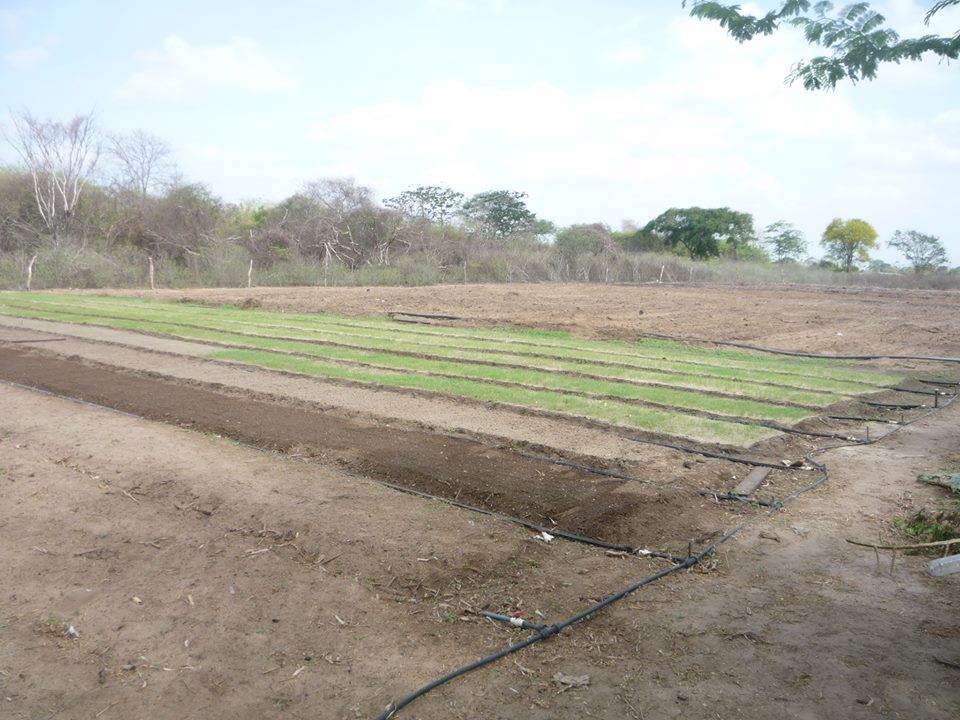
The germination takes from 4 to 5 days, after 10 days apply a foliar fertilizer with high content in (p) phosphorus + fungicides, for the rooting and development, after 25 days, apply granulated fertilizer, of the formula NPK 12-24 -12 and continue with the weekly fertilization with foliar fertilizers with complete NPK + fungicides formula and wait 45 days until the seedlings reach a height between 10 and 12 centimeters, considered the ideal for transplant. It is also vital to keep the nurseries free of weeds, because weeds affect the development of onion seedlings.
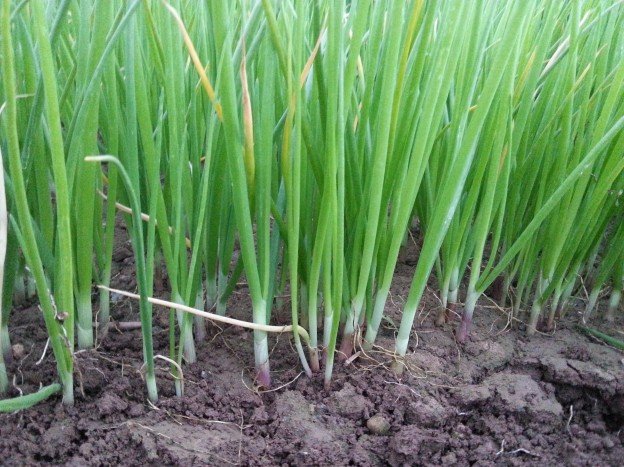
Source
Preparing the land to transplant the onion
While we wait for the seedlings to develop in the nursery, we must prepare the land, including the preparation of the furrows for irrigation. The preparation of the land is done with an agricultural tractor with the harrow equipment, this work is important, because the cultivation of the onion requires loose soil and without clods, which means that we must make several passes grada to the land.
Groove processing
The furrows are made with the same agricultural tractor, for this there is the furrower, which uses hooks that graduate at the desired distance. in the case of the onion the furrows should be at a distance of 50 centimeters, the cuts to the furrows are made manually. Then I present a groove form that is very effective for watering the onion, this model is called "fork" type because of its shape.
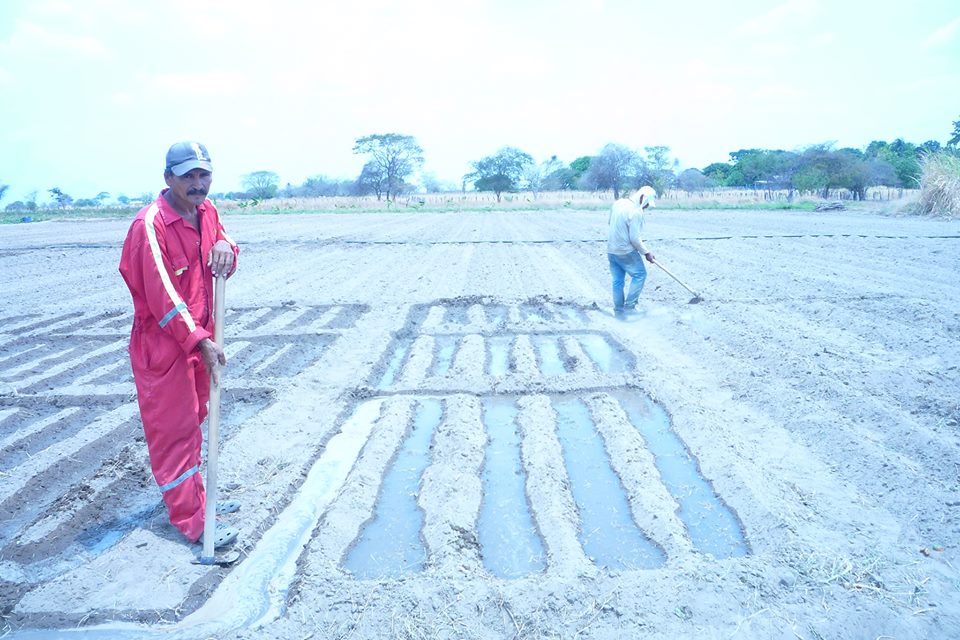
In this image you can see that the earth is getting wet to proceed with the transplant, this way of groove is done manually with the use of a tool called escardilla.
Stage of the transplant of the onion (Allium cepa)
Once the seedlings have fulfilled the time in the nursery, and are considered suitable for transplant, we proceed to take them to the field, but for this, it is necessary to carry out the following practices that I indicate below:
Step 1
- Wet the seedbeds well to loosen the soil and not mistreat the seedlings when tearing them.
- Carefully start the seedlings so they are not damaged and then cut two thirds of the leaves and are placed in boxes to take them to the field to be transplanted, as I show in the following photo:

Source
Transplanting the onion seedlings
Before planting the seedlings should be applied a first irrigation with sufficient water flow, because you have to take into account that the land is dry, so it is necessary to wet the soil well. and we proceed to plant the seedlings in rows on both sides of the furrow ridge, the seedlings are placed at a distance between 8 and 10 centimeters and at a depth that only covers the false bulb, that is, below the neck of the small plant.
Irrigation Plan:
At the beginning after the transplant, the irrigation should be done intermittently and after fifteen days, only two weekly irrigations and approximately 45 days after the bulb is observed, apply light irrigations with little water, the important thing is to maintain the humidity because there is that avoid the puddles.
Fertilization plan:
The next day after the transplant, apply a mixture of foliar fungicide plus an insecticide.
After ten days, apply the first fertilization with nitrogen fertilizers, humus or slow-acting npk formulas and continue applying every fortnight 12-24-12 or 15-15-15 In the first two months and then continue with formulas with low content of nitrogen to avoid water bulbs that are damaged quickly.
It is advisable to maintain a fumigation plan for the control of diseases, with fungicides and insecticides, throughout the crop every ten days, or before, depending on whether you observe the presence of pests or insects in the crop, and on the other hand, it is important to keep the weed-free cultivation so that the plants can develop and we can obtain good yields.
Harvesting and curing the onion
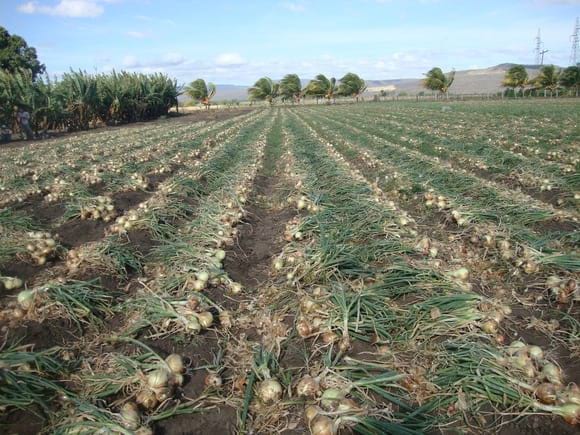
Source
It is easy to see when the onion is ready for harvesting, when the onion plant completes its vegetative cycle, begins to bend the reed, which is the leaf, which falls to one side and closes the neck above the bulb and then proceed to start and place it on the side of the furrow to finish drying, is what we call curing, there can stay 3 days is important to cover the bulbs with their same leaves, especially when the sun is very strong, because It runs the risk of being sancochen. In times of rain the producer usually takes them out without waiting for them to dry and cut the leaves at the level of the neck and then place them in a barn well spread on the floor.
Plagues and diseases
Regarding the possible pests that attack the crop, it is necessary in each fumigation to apply the mixture insecticides and / or acaricides with the fungicides, every 10 to 15 days depending on whether the presence of any pest in the crop is observed.

The cultivation of the onion is very simple, the biggest job is the transplant where there is the biggest expense for labor, so that they have an idea, with eight to ten people one hectare can be planted in a week. To be successful in this crop it is necessary to take into account three aspects: The first thing: It is that the seed we use is the one recommended for the climate where the crop will be established. Second: Take good care of the seedbeds that remain free of weeds. Third: Comply with the irrigation and fertilization plans. Fourth: Keep all areas of the crop free of weeds.
"He who supplies seed to the sower will also supply bread for him to eat, increase the crops and cause you to produce an abundant harvest of righteousness" Romans 14: 3
I hope that the present topic has helped the project STEEMCHURCH FARMS, greetings and may God bless you.
Your post is indeed the most educative post we have come across today.... am sure we @farms has learned from this post, as it covers all most all areas of onions cultivation.
Resteem
(to be a part of this community; ensure to always use #farms and #steemchurch for agricultural related post)
Thank you very much @farms, your words are very motivating, for me agriculture has always been my passion, on my farm many students come to see the crops. Soon I will present my project to STEEMCHURCH FARMS (@Farms) about growing onions, thank you for your receptivity, God bless you.
This is sweetly written, well detailed and explanatory as well, I see the way you ran me through the nutritional value, the planting process, the harvesting and the consumption as well, it's very brilliant from you.
Onions is a spice we use everyday, and I bet a lot of people does not even know about this information, thank you for writing.
Thanks to you for reading my publication, the idea is to support the project of STEEMCHURCH FARMS, greetings.
One of the most commonly consumed vegetable in Nigeria is onions. In fact, Nigeria is one of the largest producers of onions in the world with over 2 millions tonnes produced annually.
Onions offers excellent health benefits and the ease of cultivating this crop makes it a lucrative venture for any aspiring farmer. Onions is used in the preparation of most of the popular Nigerian delicacies. Some of its numerous health benefits include lowering of cholesterol, blood sugar and blood pressure levels.
Much obliged to you @marynet, this is a simple harvest to deal with, the first is to influence the beds, to transplant and keep the plants without weeds and obviously the day with manures, in a little region, 10 x 8 can flood with sprinklers, attempt it, welcome.
Hello @pirsamads, thanks for reading my publication, it is important to support the project of STEEMCHURCH FARMS, greetings.
This is sweetly composed, all around nitty gritty and illustrative too, I see the way you ran me through the nutritious esteem, the planting procedure, the gathering and the utilization also, it's exceptionally splendid from you.
Onions is a zest we utilize ordinary, and I wager many individuals does not think about this data
Hello @rameelkarim, thanks for reading my publication, it is important to support the project of STEEMCHURCH FARMS, greetings.
Thanks for sharing. Indeed onion is one of the most vital item for cooking of different meal. Onion add taate to food. Thanks for elaborating the seedling of onions and also the ateps of cultivating onions.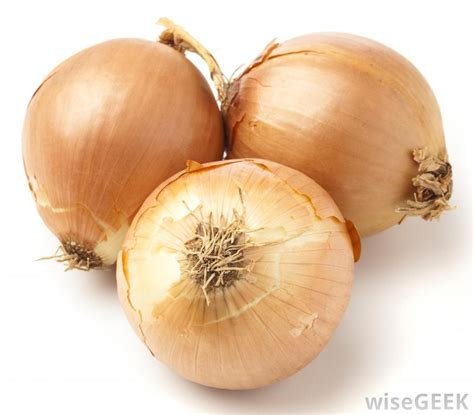
Indeed your post is very educational and informative. We all have a role to play.
Thanks for sharing.
My picture on onions
Hello @femiandrew, thanks to you for reading my publication, it is important to support the project of STEEMCHURCH FARMS, greetings.
It is a food that is characterized by its low caloric value and high fiber content. It contains significant amounts of potassium, calcium and some vitamins.
s is an easy crop to manage, the first is to make the beds, transplant and keep the plants without weeds and of course the day with fertilizers, in a small area.
This is a very informative post. The cultivation of the onion, (Alliuum cepa), has been one of my favorite crops, and one of the crops that has given me many satisfactions. Today I want to share my experiences with all members of the Steemit community, where I will explain everything related to this important crop in a simple way. The content of this course will begin with a brief review of its origin that I managed to get online. Of the vegetative cycle, the elaboration of nurseries, the transplant, the furrows for the irrigation, the fertilization, the control of weeds, the control of pests and diseases, the curing and the harvest. The onion, as it is commonly called, has a radicular system formed by numerous fasciculate radicles, of whitish color, shallow, that come out from a stem as a disc, or disc caulinar. While we wait for the seedlings to develop in the nursery, we must prepare the land, including the preparation of the furrows for irrigation. The preparation of the land is done with an agricultural tractor with the harrow equipment, this work is important, because the cultivation of the onion requires loose soil and without clods, which means that we must make several passes grada to the land.
The cultivation of the onion is very simple, the biggest job is the transplant where there is the biggest expense for labor, so that they have an idea, with eight to ten people one hectare can be planted in a week. To be successful in this crop it is necessary to take into account three aspects: The first thing: It is that the seed we use is the one recommended for the climate where the crop will be established.
Very interesting its publication on the cultivation of the onion. Very complete. I see that it takes a lot of work although you say it's easy, but it's because you're used to doing that crop. Thanks for sharing.
Thank you @marynet, this is an easy crop to manage, the first is to make the beds, transplant and keep the plants without weeds and of course the day with fertilizers, in a small area, 6 x 8 can irrigate with sprinklers, try it, greetings.
This is very elaborate! @oscarcede I feel like I can start my own onion farm already with this post as my guide...way to go man! your contribution to #farms is truly appreciated. cheers! :D
Thanks @ossyjay, friend try it, surely you will achieve it, the secret of this crop is in the seedbeds, if we obtain healthy and vigorous plants, the harvest will be a success, regards